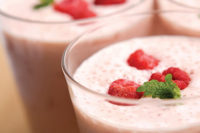
|
| Smoothies are one possible application for Ultra and yogurt powder from Grande Custom Ingredients Group. Ultra provides protein fortification and yogurt powder provides an authentic yogurt taste and texture. It is also a good source of protein. |
People need protein for survival as well as optimal health — that’s nothing new. However, recent research unveils that protein requirements may be higher than previously estimated. Also, preliminary research suggests that there is a maximum amount of dietary protein that the body can utilize at one time, leading some scientists to recommend consuming moderate amounts of protein at each meal.
To help consumers get the protein they need when they need it, manufacturers and processors can position traditional and protein-enhanced dairy foods and beverages as protein-packed meal solutions.
Dietary protein — which is composed of amino acids — is needed for growth and development and to regulate body processes, including building and maintaining muscle and bone. Additionally, recent research points to protein’s possible role in satiety, body composition, weight management and glucose control leading scientists to re-evaluate dietary protein recommendations.
The current Recommended Dietary Allowance for protein reflects the minimal amount required to prevent protein deficiency. For adults, the RDA is 0.8 grams of protein per kilogram of body weight, or 56 grams of protein daily. Many experts believe this is not enough to protect against age-related loss of skeletal muscle (sarcopenia) or to possibly reduce risk of obesity, diabetes, high blood pressure and osteoporosis. The Institute of Medicine’s guidelines are more liberal and more in line with results of recent research. The IOM recommends consuming 10-35% of total calories from protein which, for a 2,000 calorie diet, amounts to 50 to 175 grams of protein per day.
Most Americans get plenty of protein, according to Douglas Paddon-Jones, PhD, professor, Department of Nutrition and Metabolism, The University of Texas Medical Branch.
“We’re consuming 1.2-1.3 grams per kilogram per day — more than minimum requirements,” he said. “However, protein isn’t something that can be stockpiled in the body and used later. We need to get it through a meal-driven approach.”
Paddon-Jones’ research suggests that to maximize the potential for muscle growth and repair, protein should be distributed throughout the day in amounts of about 30 grams. Protein intake significantly below this level did not optimally stimulate muscle synthesis and protein intake above this level did not provide additional benefit. In light of current research, Paddon-Jones recommends consuming about 4 ounces of high-quality protein — such as milk, yogurt, eggs, seafood, lean meat, poultry and whey protein — at breakfast, lunch and dinner to maximize muscle synthesis and provide other benefits, such as satiety and glucose control.
Americans understand the benefits of protein, according to the International Food Information Council Foundation’s 2012 Food & Health Survey. The survey found that 88% know protein helps build muscle, 60% agree protein can help people feel full, and 60% believe a high-protein diet can aid weight loss. This awareness appears to influence purchases. Nearly six out of 10 consider protein when making a decision about buying packaged food or beverages. However, the focus for many (47%) is eating more protein during an evening meal rather than during other meals or snacks.
“The biggest obstacle, or opportunity, is breakfast,” said Paddon-Jones, in terms of getting 30 grams of high-quality protein at each meal. “Breakfast items such as eggs, Greek yogurt and a latte are great, but a lot of us need something convenient and simple. I recommend whey protein concentrate or isolate for breakfast — throw it into a fruit smoothie. If you’re on a budget, try skim milk powder.”
Most dairy foods are excellent sources of protein (8 ounces of milk contains 8 grams; 6 ounces of yogurt contains 6 to 10 grams; and 1 ounce of cheese contains 7 grams). Milk protein is considered a high-quality protein as it is composed of all nine essential amino acids (those that the human body is unable to manufacture) in proportions similar to amino acid requirements. In milk, approximately 80% of the protein is casein and 20% is whey protein.
In light of protein’s health benefits, manufacturers are isolating various milk proteins and utilizing them as ingredients to boost the protein content of dairy and non-dairy foods and beverages.
“We are seeing increased use of dairy proteins in the U.S. market and demand is accelerating across the globe,” said Vikki Nicholson, senior vice president, Global Marketing, U.S. Dairy Export Council. “As health and wellness agendas dominate the regulatory and government world and consumers are demanding more value from their food and beverage products, we expect this heightened interest to continue.”
Individual milk proteins have a wide range of potential health benefits and functional properties. “Casein and whey proteins are very different and depending on the type of protein ingredients used — milk protein isolate or whey protein isolate, for example — the functional characteristics are very different and therefore have different processing constraints and applications,” said Loren Ward, PhD, director of R&D, Glanbia Nutritionals, Idaho.




